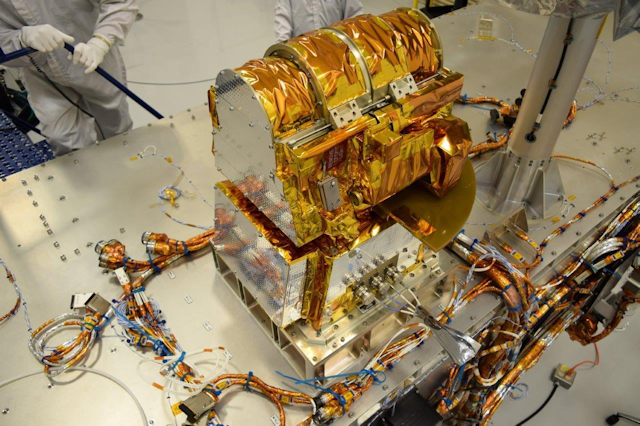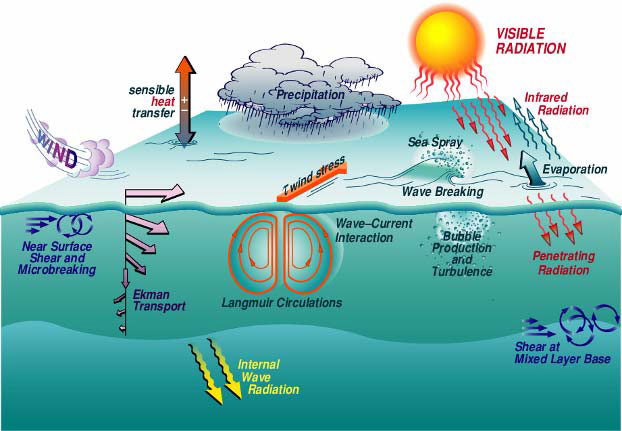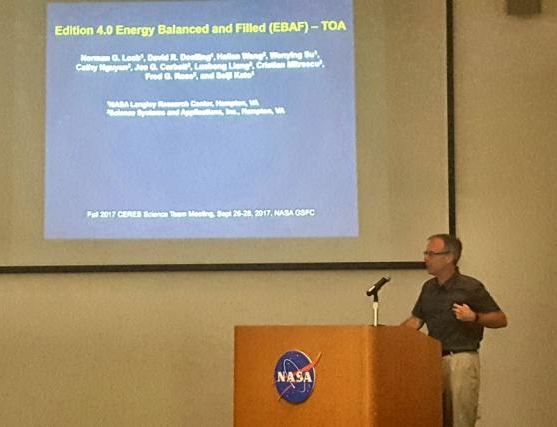28th CERES Science Team Meeting and GMAO
10.18.2017
 The 28th CERES Science Team Meeting was held at GSFC on September 26–28, 2017, and the GMAO had a strong presence at the meeting. CERES (Clouds and the Earth's Radiant Energy System) is an instrument that was first launched on the TERRA satellite in 1999 and currently flies on Aqua and Suomi-NPP. CERES measures both the solar-reflected and Earth-emitted radiation from the top of the atmosphere.
The 28th CERES Science Team Meeting was held at GSFC on September 26–28, 2017, and the GMAO had a strong presence at the meeting. CERES (Clouds and the Earth's Radiant Energy System) is an instrument that was first launched on the TERRA satellite in 1999 and currently flies on Aqua and Suomi-NPP. CERES measures both the solar-reflected and Earth-emitted radiation from the top of the atmosphere.
GMAO has had an ongoing relationship with CERES. CERES utilizes temperature and humidity profiles, as well as skin temperature, from the Goddard Earth Observing System (GEOS) in the production of several CERES products. This led to an overall theme at the meeting of characterizing how CERES products will be impacted as GMAO continues to make improvements to the GEOS system.
GMAO scientists were the featured speakers on Wednesday morning. The first three science presentations were by Santha Akella, Min-Jeong Kim, and Allie Collow. They were followed by two contributed presentation on the topic of GEOS evaluation for CERES products by external collaborators, and two invited presentations given by Steven Pawson and Arlindo da Silva.
Next, Min-Jeong Kim presented “Utilizing All-Sky Microwave Radiance Data to Improve GEOS-5 Clouds, Precipitation, and Water Vapor Analyses and Forecasts”. Her presentation covered assimilation of all-sky microwave radiance data, particularly from the Global Precipitation Measurement (GPM) Microwave Imager (GMI). At the present time, operational versions of GEOS only assimilate clear sky radiances. As shown by Min-Jeong, this limits the amount of observations that are assimilated near weather systems, including hurricanes. Experiments that include the assimilation of all-sky radiances from GMI have been promising and demonstrate the potential for improved analyses and forecasts of clouds, precipitation, and water vapor.

The last contributed science presentation was given by Allie Collow, “An Investigation of 2 m Temperature Biases and their Evaluation in GMAO's GEOS-5 Systems”. The presentation was focused on an evaluation of biases in 2m temperature within GEOS. In general, GEOS has an accurate representation of near surface temperature; however, there are seasonal, diurnal, and regional biases that are present in various configurations of GEOS. Allie pointed out a couple of these biases including wintertime biases over snow and in desert regions as well as the efforts from the modeling team to correct these biases in future versions of GEOS.

Steven Pawson gave the first of two invited science presentations with “Steps towards an Earth System Data Assimilation Capability in the GMAO”. Steven’s presentation was filled with animations that pointed out new and unique features in MERRA-2 and GEOS, beginning with an animation that depicted the history of GEOS and braches of all of the various features that have been added over time. Detailed features included a more accurate representation of the stratosphere, a look at ocean currents associated with El Niño/Southern Oscillation, and the incorporation of a tropospheric chemistry model for the development of a GEOS health quality index.
The second invited science presentation was by Arlindo da Silva, “GMAO Aerosol Assimilation: An Update”, with updates on aerosol assimilation into GEOS. MERRA-2 was the first reanalysis product to include the assimilation of aerosols. Since aerosols impact the energy budget, they are of particular importance to the CERES science team.
Mike Bosilovich represents the GMAO at CERES meetings and assisted Norman Loeb with organizing the meeting, with help from Jonathan Kelly and Lelia Marbury.

Norman Loeb, CERES Science Team Lead, presenting at the 28th CERES Science Team Meeting in Greenbelt, MD on September 26, 2017.

